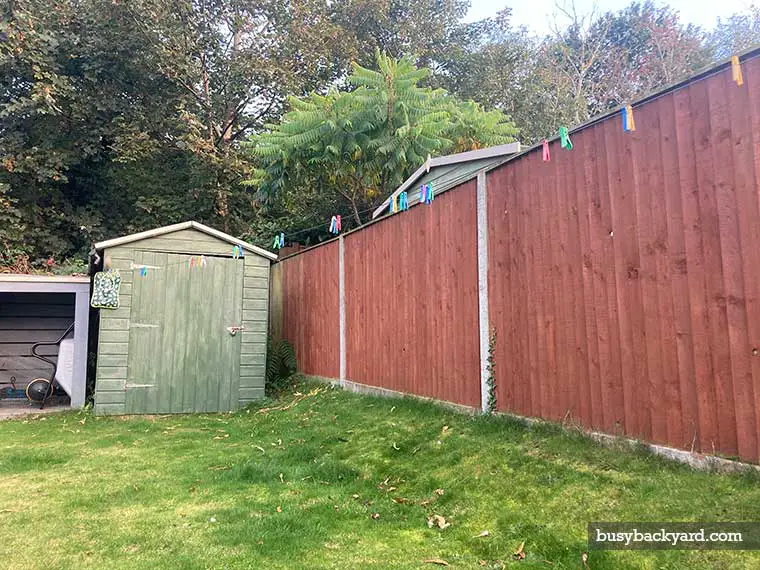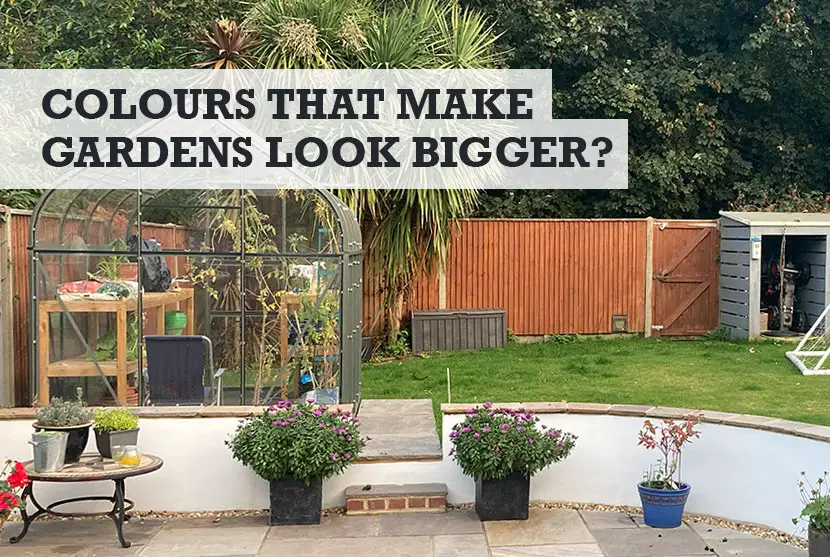Colour can really make or break how big your garden looks. With the right choice of colour fence paint, you might be able to make your garden space look bigger and longer. But if you get it wrong, the reverse can apply, with your garden ending up looking smaller than it really is.
What colour paint makes your garden look bigger? Gardening experts say that colours including green ranging through to blues and light greys painted on your fence can create the illusion that your garden is bigger than it actually is.
That’s the very quick and simple answer, but it will depend on other factors too. If you want to know how to make your garden look longer and larger, read on.
What colours make a garden look bigger?
When dealing with paints on your fence and garden, the colours, hues and tones can either make an object advance or recede. If your garden wall or fence is a feature, you need it to appear to be further away and larger than it physically is.

Another trick you can use is to make the perimeter of your garden ‘disappear’. This can be achieved through the use of colour, optical illusions and other tricks of the trade.
Thirdly, you want to stay close to nature with your colour scheme so that it blends in with your plants.
You’ve probably guessed by now that green is a great colour to help make your garden look bigger so would be a good choice. Other options include blue or grey, with a touch of green, and colours that resemble stone.
Receding and advancing colours
Colour is used by architects and garden designers for a number of reasons. It evokes mood, a sense of space and can be used to unify a theme. Colour is used to emphasize or diminish structural features. It is also influenced by personal preference.
Warm and cool hues
The colour spectrum, roughly the colours of the rainbow, ranges from warm to cool.
Warm colours tend more toward the red side of the spectrum and are more noticeable than those on the blue side. Think of how the flowers in a field of Flanders poppies grab your attention, reducing everything else to background noise.
Warm colours are said to ‘advance’ or move forward visually. This would not be desirable if you wanted your garden to feel spacious.
If you painted your garden wall red, orange, hot pink or yellow, not only would it compete with the flowers in your garden but it would be the dominant feature.
If you relish drama in your garden, you will enjoy using warmer tones. However, this colour scheme will not visually enlarge the size of the garden.
On the opposite side of the spectrum are the blues, greens and lilacs. These blend in with your foliage and do not compete for your attention. They are more relaxing on the eye.
These colours are said to ‘recede’, or to appear further away, creating the illusion of space. Your eye can linger, and move comfortably, without stress, from feature to feature. This creates a more soothing experience than warmer colours.
Green is midway on the colour spectrum, ranging from warm lime greens to teal and the cool blue greens of the sea. Green is a colour naturally associated with a garden and consequently does not jar the senses. The principles of cool and warm tones apply to the use of green tones as they do to any other colour.

Light and dark, tints and shades
Lighter colours tend to expand the sense of a space because they reflect more light rays, whereas darker colours diminish it. Equally, a lighter tint of a colour would make a structure appear larger, than darker shades of the same tone.
Therefore, a lighter blue-green would make your wall, and consequently your garden, appear larger than a darker shade would. The latter tends to focus your vision on one area, rather than expand your horizons.
The time of day
When choosing the colour scheme for your garden and structures such as walls, consider when you will be enjoying it most.
As colour is a function of how much light it reflects, it is profoundly affected by how much light falls on its surface. A painted wall will appear warmer, if you enjoy long evening meals al fresco, than if you spend most of the day lounging at the pool. The cold heat of the sun, has the same effect as applying ice blue tones.
To achieve the desired effect you will need to adjust the tone of your paint accordingly.
Latitude
Latitude also has an effect on how much light falls on any surface. The closer you are to the poles, the less intense sunlight will be, giving your surfaces a warmer appearance. In order to make your garden appear larger, you need to maximise the reflection of available light by choosing lighter tints of paint and plantings.
Making your garden wall disappear
For centuries military strategists have been using combinations of colours to create optical illusions and to camouflage objects that they wish to make invisible.
The Disney empire uses a sage green hue, throughout its theme parks, to make unsightly buildings and other structures disappear visually.
You can use the same colours and techniques in your garden.
Having chosen the colour or combination of colours that will make your garden wall invisible or appear larger, you can use additional methods to further increase the sense of space in your garden.
You can choose to add visual height, width or depth to the wall, or draw the focus away by using paint techniques and other complementary elements.
Handy Hint: These fast growing plants will grow into a privacy hedge quicker than anything else you can plant.
How to make your garden look longer and larger
Add height to your garden
Add visual height to your garden by drawing the eye upward. One method would be to paint vertical stripes in a variety of subtly different shades. This creates a 3D effect, adding both depth and height.
Another option would be to plant a vertical garden on the wall. Trellises, climbing plants and espaliered fruit trees will maximise the height of the wall without requiring the space of a large footprint.
If there are attractive trees or mountains beyond the wall, you would want to ‘borrow’ that scenery. Painting the wall a similar colour to the background will create a seamless transition to the surrounding elements and a wider landscape.
Handy Hint: Here’s how you can stop squirrels from digging holes in your lawn.
Add width to your garden
Just as vertical painting adds height to your garden, horizontal stripes or patterns will give the illusion of width.
If you need to paint walls on three sides, draw the attention away from the furtherest wall by creating features such as those described above, on each of the side walls.
If your garden is a long narrow corridor, use a colour of paint that advances at the far end and a matching tone that recedes on the sides.
Add depth to your garden
A path leading to a mirror, or a faux door in the wall, will add depth by creating the illusion that the garden continues beyond the wall.
If your budget or your talent extends to a mural or trompe l’oeil, you can create all manner of vistas to increase the pleasure of spending time in your garden.
Using your garden wall as a backdrop
A variety of tall flowering plants, in cool colours, such as blues and lilacs will soften the impact of a large wall or fence. Examples of flowers which create this cottage garden effect, are delphiniums and agapanthus.
Hydrangeas can also be forced to produce blue flowers by manipulating the pH balance of their soil. To add height and save space, in a small garden, grow them in containers.
The above-mentioned flowering plants are annuals and die back in winter. Grey green evergreen foliage of varying heights will provide interest all year round.
Making your garden wall a feature
Another strategy would be to draw attention to your garden wall while still making the space appear larger.
You can achieve this by creating a feature in a lighter, natural colour, such as creamy or grey stone. In addition you can add texture with paint effects to make it appear real.
Adding green foliage and flowering plants will incorporate the wall into your garden design.
Conclusion
With a little creativity and the right colour paint choice for your fence, there’s no reason why you can’t make your garden look bigger than it actually is.


